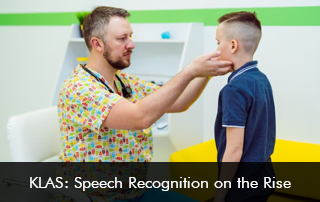Clinical documentation has been the main cause of physician burnout and clinician frustration. Fortunately, Electronic Medical Records (EMR) Software technology offers features to streamline the documentation process. This helps providers gain more time to focus on patient care.
KLAS Report – Clinical Documentation Strategies
According to the latest KLAS report, the healthcare market is embracing front-end speech recognition as the go-to clinical documentation platform.
Documentation Technology Solutions
The KLAS report examines different documentation technology tools and services and how they aid users.
Front-End Speech Recognition
The interviewed organizations revealed that front-end speech recognition technology has enhanced over the last few years. Front-end speech recognition is precise and offers the flexibility to be used in a variety of platform types.
Healthcare providers can use their smartphones to capture dictation and review patient notes. The only downside to the robust technology is its expensive price.
Transcription Services
As speech recognition tools are on the rise, healthcare organizations and clinicians are moving away from in-person scribes and transcription services. Though, respondents expressed that transcription services play a vital part in EHR software documentation.
Scribes and transcriptionists are useful for doctors who are hesitant to use speech recognition technology. Scribes can aid practitioners by assisting them in the tedious documentation process.
Virtual Scribes
94% of the respondents feel that virtual scribes have a positive impact on documentation time. Users revealed that virtual scribes complete clinical documentation at the end of the day.
Respondents said that the main issue with virtual scribes is the inconsistent quality of transcribers.
Computer-Assisted Physician Documentation
Respondents had affirmative views about computer-assisted physician documentation as they made code capture efficient, increased revenue, and reduced documentation time.
However, some physicians stay away from CAPD because they don’t fit with the clinician’s workflow and offer too many recommendations.
Developments in the Speech-Recognition Market
Ambient-speech recognition technology in the medical field is still a newer market and is developing. The ambient-speech recognition market is booming and KLAS is hopeful to measure the success of these solutions shortly.
Ambient speech recognition tools leverage automatic speech recognition and natural language processing (NLP) to document patient and provider conversations in the Electronic Health Records software. The powerful technology can help alleviate clinician burnout and improve provider satisfaction at work.







